Ready to take a ride with your bike around the hood? Perhaps through the busy streets of your town?
Great!
This article will provide actionable tips on how you can increase your biking safety. In it, you’ll learn why biking safety is essential, tips, rules, etc.
Without further ado, let’s get started…
Table of Contents
Why Is Bike Safety So Important?
In 2017, a whopping 783 bicyclists 8 were killed in separate crashes in the USA. Consequently, in such fatal crashes, it is the cyclist who sustains fatal bodily injuries.
It is estimated that almost 300,000 kids are rushed to the emergency due to cycling injuries and out of this, 10,000 are admitted for three days or so. Some injuries such as head injuries can be extremely fatal.
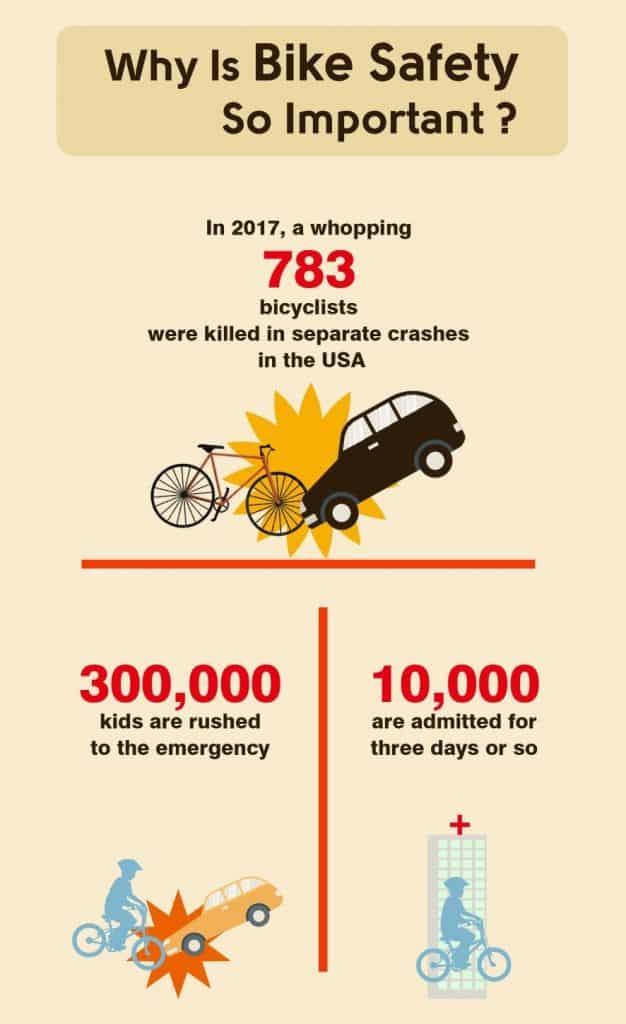
So, find out ways you can avoid accidents and deaths and always remember that bicycle crashes are avoidable if cyclists and motorists follow the rules and take notice of each other.
A Checklist to Ensure a Safe Biking Experience
In this section, we will cover the crucial biking safety checklist both for the rider and the bike. Before you embark on your ride, ensure everything is ticked “Yes.”
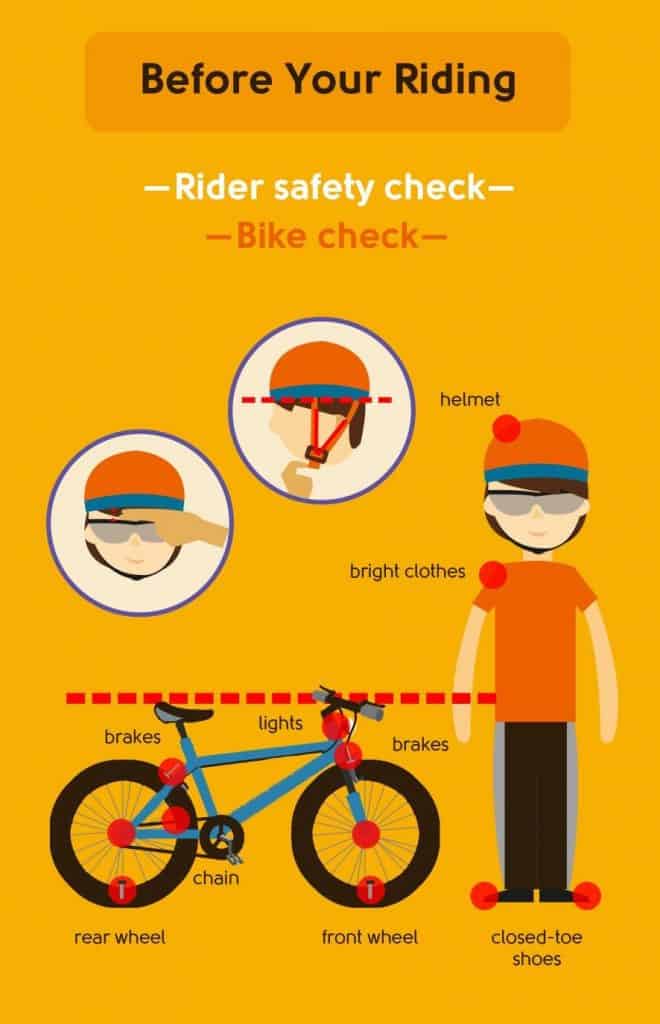
- Rider safety check
A rider safety check is simply ensuring you have the necessary protective gear such as helmet, bright clothes and closed-toe shoes.
They not only improve your safety but present you with a comfortable riding experience.
The following guideline will not only allow you to fit your helmet efficiently but also significantly bolster your biking safety.
If a box is checked “NO,” proper adjustment is required.
| YES | NO | |
| Is the space between the helmet and eyebrows two fingers? | ☐ | ☐ |
| Do the helmet straps lie flat against the face? | ☐ | ☐ |
| Side buckles make a ‘V’ shape under the ear lobes. | ☐ | ☐ |
| After fastening is there a finger width gap in between the chin and the chin strap? | ☐ | ☐ |
| Is there a CSA, CPSC, ASTM, SNELL B-95 or N-94 approval on the inside of the helmet? | ☐ | ☐ |
| After carrying out the above guidelines, does the helmet stay intact? | ☐ | ☐ |
| Do you have bright clothes on? | ☐ | ☐ |
| Do you have closed-toe shoes on? | ☐ | ☐ |
- Bike check
Before taking a ride, please go through the following bike checklist for a safe ride. If you tick “No” in any of the items, conduct adjustments where need be.
| Item | Yes | No | ||
| Size | Can straddle with feet fully stretched on the ground | ☐ | ☐ | |
| Warning devices | Does it have a horn or bell? | ☐ | ☐ | |
| Lights and reflectors | Does it have a White reflector on the front? | ☐ | ☐ | |
| Does it have a Red reflector on the back? | ☐ | ☐ | ||
| Do night lights work at night? | ☐ | ☐ | ||
| Handlebars | Are they in line with the wheel? | ☐ | ☐ | |
| Are they tightly fitted? | ☐ | ☐ | ||
| Tight grip? | ☐ | ☐ | ||
| Are tubing covered? | ☐ | ☐ | ||
| Brakes | Coaster brakes | Stops quickly and evenly | ☐ | ☐ |
| Hand brakes | Cable not rusted | ☐ | ☐ | |
| Stops quickly and evenly | ☐ | ☐ | ||
| Frame | Is it Straight | ☐ | ☐ | |
| Are there cracks | ☐ | ☐ | ||
| Front-wheel | Little or no wobble | ☐ | ☐ | |
| Does it Spin easily? | ☐ | ☐ | ||
| Tire fully inflated | ☐ | ☐ | ||
| Treads are easily seen | ☐ | ☐ | ||
| Rear-wheel
|
Little or no wobble | ☐ | ☐ | |
| Does it spin easily? | ☐ | ☐ | ||
| Tire fully inflated | ☐ | ☐ | ||
| Treads are easily seen | ☐ | ☐ | ||
| Spokes | All intact | ☐ | ☐ | |
| Straight and tight | ☐ | ☐ | ||
| Seat | Ideal height (easy to get on and off) | ☐ | ☐ | |
| Straight and tight | ☐ | ☐ | ||
| Crank
assembly |
chain not rusted | ☐ | ☐ | |
| Pedal trend not worn | ☐ | ☐ | ||
| Pedal is tight and spins easily | ☐ | ☐ | ||
Abide By the Rules: Avoid Accidents and Arrests
In numerous USA states, bicycles are considered as cars. As such, cyclists have similar rights and obligations as motorists.
In case you are thinking of taking a ride, here are some of the rules you should abide by to guarantee biking safety:
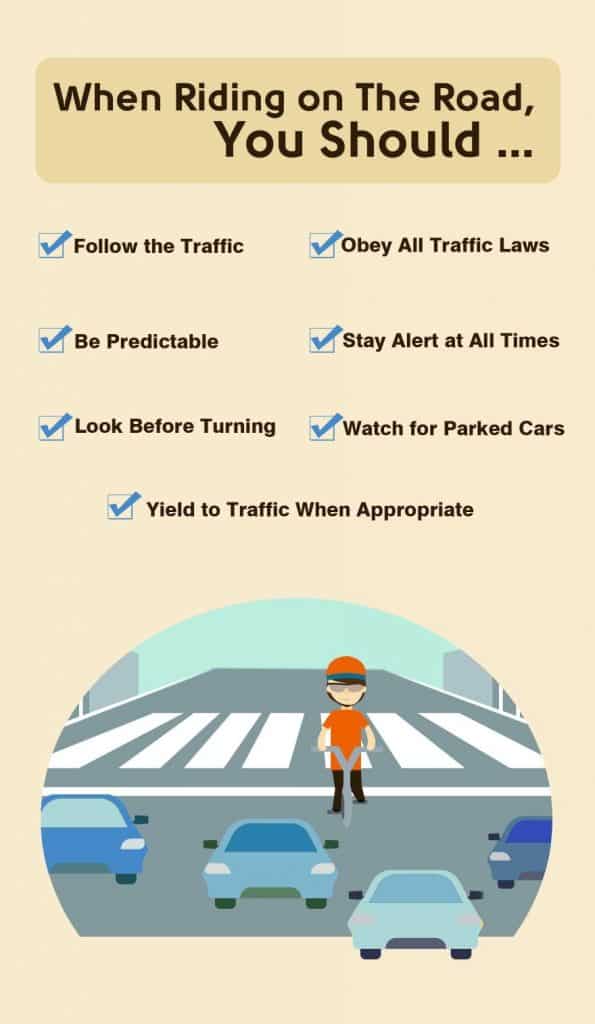
- Follow the Traffic:
Always go in the direction other vehicles are moving, these days, we find that you also need to pay attention to the electric scooters. And ride on the right side. Avoid taking lanes that move in the opposite direction of the traffic flow.
- Obey All Traffic Laws:
Again, a bicycle is a vehicle, and as such, you are the driver. Therefore, obey lane markings, signals, and lights in whichever street.
- Follow traffic as it is:
you should:
-
-
Always cycle in relation to the traffic speed
-
Drivers moving fast must lower their speed in accordance with slower or stopped traffic ahead. Vehicle operators must travel in a pace that will allow them to brake within their sight distance.
As a cyclist, you have the right to use the roadway, and motorists should respect you. However, you should be predictable and visible for this to happen.
-
-
Obey traffic rules and lights before entering an important road
-
In a bid to improve biking safety, obey traffic signals and lights. It is the surest way for motorists to predict your next move.
As seen from the picture below, the cyclists are obeying the traffic lights and keeping a distance between them and the curb.
Occasionally, when there are no cars on cyclist’s lane, a demand-activated traffic signal will not turn green. Why?
Because the inductive loop sensors that detect conductive objects may not detect a bicycle. As such, you should place your bike in the most sensitive part.
-
-
Look back before moving sideways
-
Whether taking a turning or avoiding an obstacle, you’ll be required to move sideways. To avoid violating the rights of another road user or a crash, always look back.
While this is a hard skill to assimilate, you can practice on empty streets or parking lots. Practice turning both rightward and leftward while cycling in a straight line.
Additionally, practice making hand signals and don’t keep your head turned for long to avoid collision with objects ahead of you.
Again, swerving in and out between cars that are parked is not recommended. And to avoid getting hit by opening doors, stay 3-4 feet away from parked vehicles.
-
-
Respect pedestrians
-
Finally, you must yield to pedestrians when bicycling, especially in crosswalks or intersections. As you approach an intersection or crosswalk, always scan for pedestrians left, right and center.
If they are crossing or waiting to cross, apply brakes, and yield the right of way. After the crosswalk is clear, you can proceed.
- Use appropriate hand signals:
Aim to ride in a straight line and avoid swerving in and out of cars. Likewise, use hand signals to let other road users know where you are going.
- Avoid distractions:
Utilize your ears and eyes. Watch out for obstacles such as railroads, storm gates, cracks, potholes, wet leaves, or anything that could potentially cause you to lose balance.
Avoid wearing a headset so that you can hear oncoming traffic.
- Scan all directions:
When turning right or left, always look back for a break in traffic. Then, use a hand signal before making the turn. Additionally, always be on the lookout for traffic turning left or right.
- Avoid getting close to parked cars:
Again, ensure you keep a 3-4 feet distance between you and parked cars. This will protect you from being doored or being slammed by pulling out vehicles.
12 Safe riding tips that will Significantly Mitigate Crashes
In this section, we will highlight 12 tips that if followed, will guarantee a safe ride. Let’s have a look.
1. Wear a fitting helmet
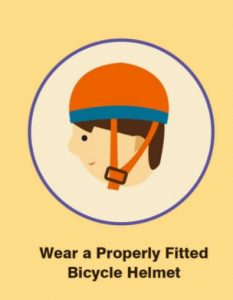
Wearing a helmet can significantly reduce the chances of brain damage by 88%. If you are an under 17-year-old cyclist in New Jersey, then the Helmet Law 39:4-10.1 requires you to wear one.
2. Adjust the bike to the ideal height
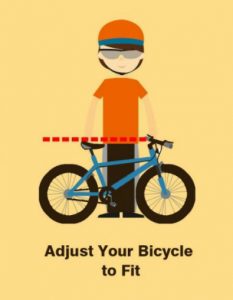
In addition to performing the checklist above, you ought to ensure that the seat and handlebar height should be at the same level.
Likewise, the height of the seat should allow a slight knee bend when your leg is fully stretched.
When using a road bike, ensure there is a 1-2 inch space between you and the top bar. And is using a mountain bike, space should be 3-4 inches.
3. Double-check the equipment
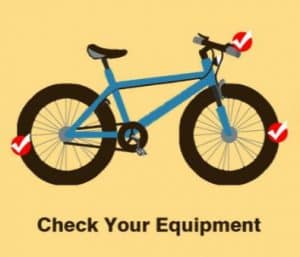
To significantly boost your biking safety, check the conditions of the equipment. Ensure, and rare brakes are working, and the tires are inflated.
4. Become visible
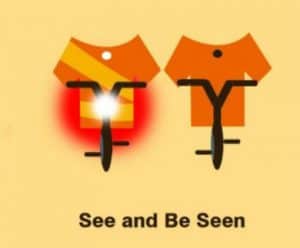
Regardless of the time of day, others need to see you. Wearing white will not make you visible, instead, wear fluorescent or neon when riding at night or day.
Alternatively, you can wear something reflective such as a reflective jacket or have a flashlight. Seeing a vehicle doesn’t mean a driver can see you; take the right precautions.
5. Have Full Control of the Bike

Always have two hands on the handlebars; at least one. If you have books or other times, carry them in your backpack or the bicycle carrier.
6. Spot and Avoid Road Hazards
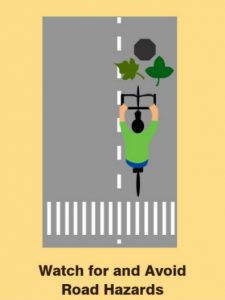
Look out for potholes, wet leaves, stones, etc. to avoid a crash. If you are leading a group, signal other members where the hazard is.
7. Avoid Swerving Between Cars
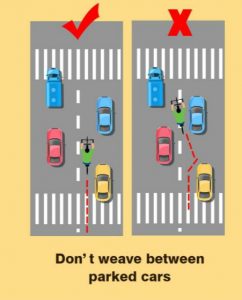
Travel in a straight line to become visible to other road users.
8. Keep a 4ft Distance Between You and Parked Cars
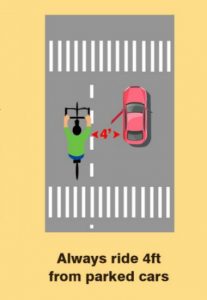
This will prevent getting injured or doored.
9. Avoid Distractions
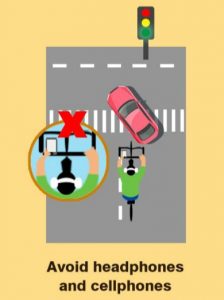
They’ll distract you, and you might cause a crash. Be attentive and use your eyes and ears, get rid of the headphones and phones while riding.
10. Use Appropriate Signals
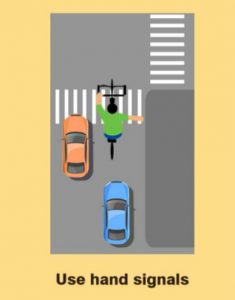
When turning, always use hand signals to let other road users know your next move.
11. Avoid riding on sidewalks
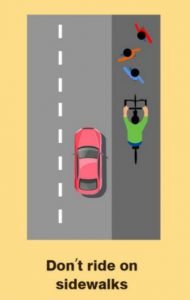
Remember, a bicycle is a vehicle. Additionally, you are at high risk of causing accidents with pedestrians.
12. If Possible, Avoid Night Rides
Your biking safety is at a higher risk since at night, few can see you.
If you have to, wear reflective clothing and make sure the bicycle’s front and rear reflectors are working. Always, have reflectors on your tires.
10 Common Crashes and How To Avoid Them
-
The Right Cross
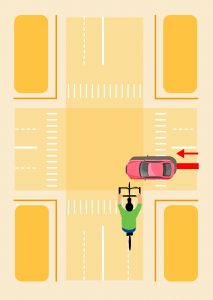
By far, this is the common cause of bicycle crashes.
You can get hit in two ways; either when a car is pulling out of a parking lot, driveway or side street on the right and hits from behind or car pullouts in front of you and you slam on to it.
How can you avoid a possible collision?
- Purchase a headlight:
This is especially crucial when riding at night, and it is a requirement by the law. A front headlight will ultimately make you more visible.
During the day, you can use a white light that has a flashing mode.
Alternatively, you can use a headlamp attached to your helmet
- Yell, wave or use a bell:
It’s easier for a driver to see a waving hand than an approaching bicycle. You can also use a horn or bell.
3. Stop:
When you can’t make eye contact, slow down to avoid getting hit.
4. Use the whole lane:
While most cyclists prefer riding near a curb or on the bike lane, an approaching motorist will not see them since he is looking for other drivers who are always further left.
As such, aim to ride near the middle of the road for them to see you.
-
Being Doored
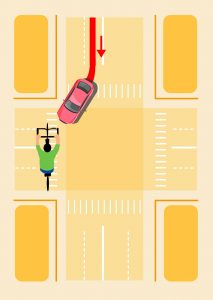
Happens when a driver suddenly opens the door right in front of you. If you can’t stop, you slam into it. It is recorded to be the second cause of bike crashes in Toronto 4.
How can you avoid a collision?
Use the whole lane:
This is the surest way to avoid getting doored. While you might think to do so can lead to crashes with other vehicles on their lane, it is by far safer than riding near parked cars.
-
Crosswalk accidents

It happens when crossing the street at a crosswalk and then suddenly a car makes a right turn hitting you. This kind of collision occurs since drivers do not expect bicycles at crosswalks.
A study shows that sidewalk-riding is more dangerous than road riding.
How can you avoid a collision?
- Stop:
Slow down until you stop to avoid getting hit
2. Buy a headlight:
A headlight is essential at night and is required by law.
3. Keep off sidewalks:
Crossing between sidewalks is perilous.
If done on the left-hand side of the street you risk being hit by an oncoming vehicle while doing it on the right side of the road, increases the chances of being hit by a car behind you.
Besides, you risk getting hit by pulling out cars and is dangerous to pedestrians too.
-
Riding against traffic
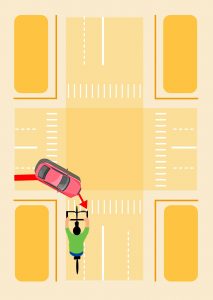
Imagine riding against traffic flow, then a car makes a right turn from a parking lot and right into you. Why did this happen?
Because the motorist was looking for traffic on their left and not the right side. Furthermore, an oncoming car can as well hit you.
How to avoid a collision
Always ride with traffic flow. And here is why:
- Cars pulling from parking lots, driveways or cross streets making a right turn do not expect incoming traffic from the opposite direction.
- It’s impossible to make a right turn
- Cars moving in the opposite direction are at a much higher speed, and you risk fatal crashes.
- It is against the law to ride against traffic.
-
Driver not seeing you
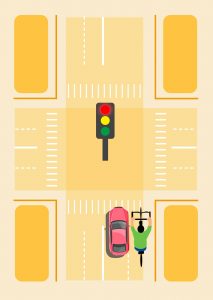
This collision happens when you approach a car waiting for the traffic lights to go green by its right side.
Unfortunately, the motorist can’t see you, and once the light goes green and you move forward, the car makes a right turn hitting you.
How to avoid a collision
Avoid stopping in blind spots: stop behind the car where the vehicle in front and behind you can see you.
Alternatively, you can still stop on the right side but in front of the car where the driver can see you.
Also, avoid passing stopped cars on their right side since you might get doored by an existing passenger.
-
The Right Hook
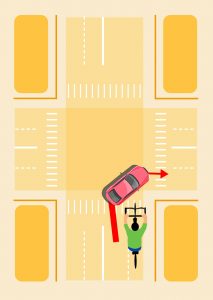
It occurs when a vehicle passes; you and makes a right turn in front of you. Probably the motorist thinks you are moving slow.
The worst part is that it is hard to avoid this kind of collision since it happens suddenly.
How can you avoid a collision?
- Avoid riding on the sidewalk:
It is hard for motorists to see you when coming out of a sidewalk.
2. Ride on the left side:
Take the whole lane; this will prevent drivers from turning into you. Furthermore, if the lane is too narrow to overtake, the motorists will have to take the whole lane also.
3. Use your mirror before entering an intersection:
Before approaching an intersection, use your mirror and while in it, pay attention to what’s in front of you.
-
Being hit as you overtake
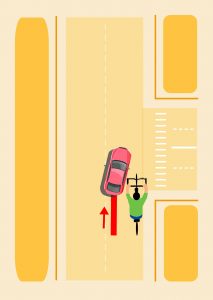
It happens when you are overtaking a slow-moving car or bicycle on its right side when immediately it makes a right turn hitting you.
How can you avoid a collision?
- Avoid overtaking on the right:
Never pass a slow-moving car on the right. Just slow down and wait for it to accelerate. Alternatively, overtake on the left side. In case of a cyclist, shout “on your left” when overtaking.
2. Look back before turning right:
Doing so will aid avoid collision with cyclists passing you on the right or those approaching from the sidewalk.
-
The Left Cross
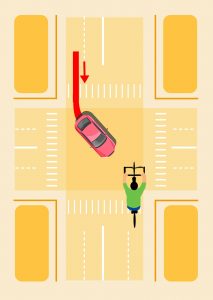
The left cross happens when a car approaching you makes a left turn hitting you.
How to avoid a collision
- Avoid riding on the sidewalk:
Motorists can’t see you when approaching the road from a street.
2. Invest in a headlight:
Itis a must-have gadget when riding at night and is required by law.
3. Wear brightly colored clothes:
Wear an orange or yellow reflective jacket. Plus reflective leg bands can crucially improve your biking safety.
4. Avoid overtaking on the right:
Again, avoid overtaking slow-moving cars on their right. A vehicle can make a right turn, or you could get doored by an alighting passenger.
5. Slow down:
When the driver can’t see you slow down and stop to avoid a collision.
-
Being hit from the behind as you swerve back to the road
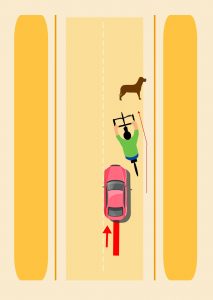
It occurs in a situation where you swerve to the left to avoid an obstacle or a parked car, only for a vehicle behind you to hit you.
How to avoid a collision
- Always look behind you before moving to the left: Motorists will hit you even if you move an inch to the left. As such, practice cycling in a straight line.
- Avoid swerving in and out of a parking lot: Swerving in and out increases the risk of being hit from behind.
- Buy a side mirror: It helps monitor traffic behind allowing you to make informed decisions.
- Always signal: The motorists will predict your next move and slow down.
-
Being hit from behind
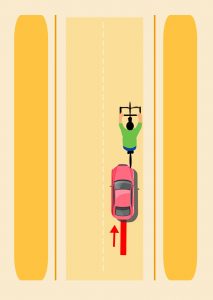
It is one of the hardest to avoid collisions to avoid since a cyclist gets hit by a car from behind. However, it is not that common as it constitutes of 3.8% of all crashes.
How to avoid a collision
- Invest in a rare light:
A flashing red rare light is ideal for a motorist to see you.
2. Choose wide streets:
Ride on streets whose outside lane is wide enough to fit a car and a bicycle.
3. Go for slower streets:
The slower a vehicle moves, the higher the chances of a driver seeing you.
4. Use neighborhood streets on weekends:
On Saturday and Sunday, the streets are full of drunkards. As such, it is advisable to use back streets.
5. Wear a reflective vest, alternatively a safety triangle: They make you more visible.
6. Buy a side mirror:
A mirror helps you scan the traffic behind you before making a turn.
7. Avoid getting close to the curb:
You are more prone to a right cross when you hug the curb tightly. Also, have some space between you and the curb.
Safety Cycling Q&A
- Q: What should you always wear when cycling?
A: helmet
2. Q: Which side of the road are you supposed to ride?
A: On the right-hand-side
3. Q: What should you do before making a turn?
A: Look behind or use a mirror to scan traffic, if clear make the appropriate hand signal
4. Q: Which hand should you pull out when making a right turn?
A: The right hand
5. Q: Which hand should you pull out when making a left turn?
A: The left hand.
6. Q: When you approach a stop sign, what should you do?
A: Stop, look to the right, left and in front, listen to incoming traffic. If clear, proceed.
7. Q: Which hand sign signals you are stopping?
A: Pulling your left arm out and down when the palm is facing back.
8. Q: Which instrument on your bike signals people that you are approaching?
A: A horn or bell.
9. Q: What is the right thing to do when passing a pedestrian?
A: First ring the bell, slow down and upon getting close tell them that you are approaching.
10. Q: Which color should your clothing be when bicycling?
A: You should wear bright colored clothes, specifically orange or yellow. Additionally, the clothes should be reflective.
11. Q: Should you ride your bike when crossing at a pedestrian sidewalk?
A: No, you should get off and walk like other pedestrians to avoid getting hit.
12. Q: What’s the importance of wearing a helmet?
A: To protect your head and brain. Helmets prevent head injuries by 88%.
13. Q: What should you do to your bicycle every spring?
A: Ensure your bike is tuned-up – this includes adjusting the brakes, shifting, bottom brake, headset, and hubs. Plus tightening all bolts.
14. Q: What should check every time you take a ride with your bicycle?
A: One should check the:
-
- Air
- Brakes
- Chain
- All the above.
- Q: Which two rules are the most important?
A: Aim to ride on the right side of the road, get off your bike and walk across the street, look back and use proper hand signal when turning, stopping, etc.
16. Q: Who is supposed to wear a helmet when cycling?
A: At least everybody is supposed to wear a helmet to protect the head. The law stipulates that anyone under 18 should wear one.
17. Q: What is the most appropriate thing to do before entering a street when cycling?
A: Stop and look to the right and left and ensure nobody is approaching, then proceed.
18. Q: Can two people ride one bike?
A: No, the bicycle is designated for one person.
19. Q: Apart from cyclists, which other athletes wear helmets when sporting?
A: Baseball players, hockey player, football players
20. Q: How should a group ride?
A: In a straight line with ample space between cyclists.
21. Q: Most bicycle crashes reported happen less than five blocks from home? True or false
A: True
22. Q: You should wear a helmet only when going for long cycling trips. True or false?
A: False. You should always wear one, no matter how small the distance.
23. Q: What is the most appropriate thing to do when you approach a traffic light, and it turns yellow?
A: Stop
24. Q: When cycling, what side should you pass a pedestrian?
A: On the left side.
25. Q: Can you use a hockey helmet for cycling purposes?
A: No. A hockey helmet is for hockey while a bicycle helmet is for cycling.
26. Q: What should you do when cycling in the dark?
A: Turn the flashlight on or get off the bicycle and walk home.
27. Q: Laws that govern motorists are similar to those that govern cyclists. True or false?
A: True. A bicycle is regarded as cars by the law.
28. Q: which three hand signals should a cyclist be well versed in? ( let the students show you these signals)
A: Right turn – right hand out
Left turn – left hand out
Stop – left hand out and down with palm facing back
29. Q: You should purchase a bike that will ultimately fit you in the future? True or false.
A: False. You should buy a bicycle that fits you such that you can straddle with both fit firmly on the ground.
30. Q: The width between the helmet and the eyebrows should be two finger widths. True or false?
A: True
31. Q: If involved in a crash with your helmet and it doesn’t get a crack, it is okay to continue using it. True or false?
A: False. You should get a new one.
32. Q: What should you look out for when buying a helmet?
A: A CSA, CPSC, ASTM, SNELL B-95 or N-95 approval label.
33. Q: Which are the leading causes of bicycle injuries? (2)
A: Open door: Use a horn or bell to notify a motorist you are approaching
Not being seen: Use bike lights and reflective
Drivers failing to yield: Cycle away from curbs
34. Q: Which are the best and worst cities to bike?
A: What makes a metropolis bike-friendly is due to several factors such as cycle-loving laws, easy terrain, drivers that respect cyclists and motorless persons.
According to Forbes and Bicycling Magazine, these are the ideal cities for bikers: (listed in particular order).
-
- Portland, OR
- Minneapolis, MN
- San Francisco, CA
- Seattle, WA
- Tucson, AZ
- Sacramento, CA
- Washington, DC
- Denver, CO
- Mesa, AZ
- Madison, WI
- Austin, TX
- Chicago, IL
- Eugene, OR
- Philadelphia, PA
- Boston, MA
Below are cities termed unfriendly for cyclists.
This is due to air pollution, lack of highway roads that spice up bicycling, devoid of bike-lanes, and unrestricted urban growth. They include:
-
- Dallas, TX
- Houston, TX
- Atlanta, GA
- Memphis, TN
- Jacksonville, FL
- Birmingham, AL
Conclusion
By now we believe you’ve had some ‘aha’ moments. We have too!
We hope this biking safety article has been of great help.
What do you think needs to change to improve bicycling safety? Or rather, what can you do to enhance your biking safety?
Let us know in the comment section below.
You may also like:


Leave a Reply